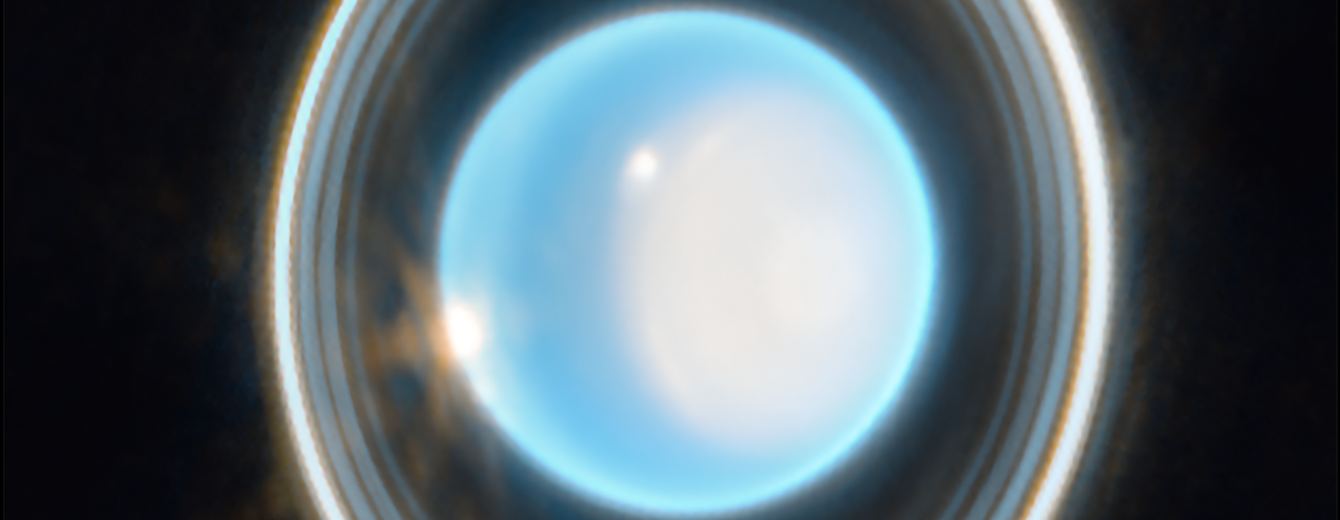The James Webb Space Telescope has taken a stunning new image of the ice giant world Uranus. But what stands out most is the dramatic new view of the planet’s rings, which show up as never before with JWST’s infrared eyes.
Instead of being faint and wispy, the rings show up brilliantly. Additionally, bright, luminous features in the planet’s atmosphere show how an extensive storm system at the north pole of this planet getting larger and brighter.
But you’ll also want to see the full-frame image view, which also shows the six largest of Uranus’ 27 known moons. And, as we’ve become accustomed to seeing in JWST images, several distant background galaxies. Yes, every JWST image is a Deep Field!

IMAGE PROCESSING: Joseph DePasquale (STScI).
This is JWST’s first detailed look at Uranus, and it demonstrates the observatory’s unprecedented sensitivity. Uranus’ faint dusty rings have only ever been imaged by two other facilities: the Voyager 2 spacecraft as it flew past the planet in 1986, and the Keck Observatory with advanced adaptive optics in 2007. Unlike the rings of Saturn, which are very bright and composed of water ice, the rings of Uranus are relatively dark – even though they show up brightly in this new infrared image. Instead of containing dust, the rings seem to be made up of larger chunks, measuring 0.2 to 20 meters across.

Uranus has 13 known rings and 11 of them are visible here. NASA says that some of these rings are so bright in this new image that they appear to merge into a larger ring. Nine are classed as the main rings of the planet, and two are the fainter dusty rings (such as the diffuse zeta ring closest to the planet) that weren’t discovered until Voyager 2’s visit. Scientists expect that future Webb images of Uranus will reveal the two faint outer rings that were discovered with Hubble during the 2007 ring-plane crossing.
The large bright storm is growing slowly as the planet approaches the peak of summer in its northern hemisphere. Of course, Uranus is tilted on its side, and so the north pole is can be found where the equator would be on our Solar System’s other planets.
It takes Uranus takes 84 years to orbit the Sun, and currently, it is late spring for the northern pole. The planet’s northern summer will be in 2028. If you recall in the Voyager 2 image, below) from its 1986 flyby, the planet’s atmosphere appeared clear and nearly featureless. At that time, it was summer at the south pole. The south pole is now on the ‘dark side’ of the planet, out of view and facing the darkness of space.

The Space Telescope Science Institute said this infrared image from JWST’s Near-Infrared Camera (NIRCam) combines data from two filters at 1.4 and 3.0 microns, which are shown here in blue and orange, respectively. The planet displays a blue hue in the resulting representative-color image.
Also, compare what Voyager 2 saw for Uranus’ rings, versus what JWST is showing us today:

Scientists say that studying the rings can help us understand more about Uranus, including helping to map the planet’s interior.


I’m puzzled by the shape of the rings. Are they ovoid due to the nature of the JWST imaging pipeline, or are they ovoid because the plane of the rings is not quite perpendicular to the JWST line of sight? The fact the inner rings appear equidistant from Uranus’ surface suggests to me the ovoid shape is down to the JWST imaging pipeline. Can anyone comment on this?